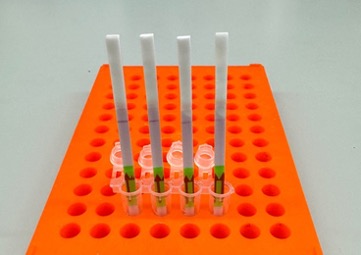Low-Cost CRISPR-Based Paper Strip Test to Improve Flu Diagnosis and Surveillance
June 26, 2024
Source: drugdu
 386
386
 Annually, less than 1% of people who contract the flu are tested, largely due to the need for skilled personnel and sophisticated equipment. Now, researchers have developed a low-cost paper strip test that could enable more individuals to determine the type of flu they have and receive appropriate treatment.
Annually, less than 1% of people who contract the flu are tested, largely due to the need for skilled personnel and sophisticated equipment. Now, researchers have developed a low-cost paper strip test that could enable more individuals to determine the type of flu they have and receive appropriate treatment.
This innovative test developed by researchers from the Broad Institute of MIT and Harvard (Cambridge, MA, USA) and Princeton University (Princeton, NJ, USA) employs CRISPR technology to differentiate between the primary seasonal flu types, influenza A and B, and the subtypes H1N1 and H3N2. It can also identify strains resistant to antiviral treatments and could potentially extend to detecting swine and avian flu strains, including H5N1, which currently affects cattle. This could enhance both outbreak response and clinical care by making accurate, affordable, and rapid testing accessible in doctors’ offices and laboratories across the world. The test is based on a technology known as SHINE, developed by the team in 2020, which uses CRISPR enzymes to identify specific viral RNA sequences in samples. Initially applied to detect SARS-CoV-2 and its variants Delta and Omicron, the technology was adapted in 2022 to screen for widespread viruses like the flu, aiming for use in field or clinic settings outside traditional hospital or diagnostic lab environments.
Traditional diagnostic methods like polymerase chain reaction (PCR) involve long processing times, specialized training and equipment, and the need for deep freeze storage for reagents. In contrast, the SHINE assay operates at room temperature and completes in about 90 minutes. The only equipment required currently is an affordable heat block to heat the reactions, and efforts are underway to reduce the result time to 15 minutes. The researchers have also fine-tuned SHINE to differentiate between various flu strains and suggest it might later be adjusted to identify different viruses with similar symptoms, such as influenza and SARS-CoV-2. This capability could aid clinicians in deciding whether to administer treatments like Oseltamivir, which is only effective against certain flu strains. In outbreak scenarios, rapid testing could also enable more targeted sample collection to better track virus spread. Moving forward, the team plans to further adapt SHINE for detecting both avian and swine influenza strains.
“Ultimately, we hope these tests will be as simple as rapid antigen tests, and they’ll still have the specificity and performance of a nucleic acid test that would normally be done in a laboratory setting,” said Cameron Myhrvold, assistant professor at Princeton University and co-senior author on the study, which was published in The Journal of Molecular Diagnostics on June 18, 2024.
Source:
https://www.labmedica.com/molecular-diagnostics/articles/294801618/low-cost-crispr-based-paper-strip-test-to-improve-flu-diagnosis-and-surveillance.html
Read more on
- Breaking the Mold and Forging a New Path! From Insulin Technology Pioneer to Global Innovation Competitor December 4, 2025
- A subsidiary of Kingfriend Pharmaceutical Co., Ltd. has received FDA approval for its self-developed injectable dapavancin December 4, 2025
- Major ophthalmic new drug successfully completed Phase III trials December 4, 2025
- Simcere Pharmaceutical and Wangshan Wangshui have reached an exclusive licensing agreement for deuterium remidevir hydrobromide for new indications such as RSV infection December 4, 2025
- SAL0140 tablets approved for clinical trials for the treatment of chronic kidney disease December 4, 2025
your submission has already been received.
OK
Subscribe
Please enter a valid Email address!
Submit
The most relevant industry news & insight will be sent to you every two weeks.



